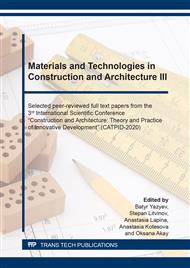p.123
p.130
p.136
p.144
p.151
p.158
p.164
p.171
p.179
The Influence of Salts’ Presence in the Materials on their Moisture and Thermal Conductivity
Abstract:
Energy saving in buildings is largely determined by the energy efficiency of the external building envelopes. The latter, as a rule, are the multilayer and incorporate structural and heat-insulating layers. The presence of individual hygroscopic salts and their mixtures in building materials changes their physical and chemical properties. Due to the increase in the sorption properties of building materials and changes in the inter-pore substance composition, humidity increases and the heat-protective properties decrease. This paper presents the results of the experimental and theoretical studies on the salts’ effect assessment on the change in moisture content and thermal conductivity of building materials due to the salt solutions and crystals’ presence in the pore space. To study the saline building materials’ thermal conductivity, the mathematical modeling methods using the theory of flow and bringing the materials’ structure to a unit cell are used. It is shown that the change in thermal conductivity occurs due to the crystalline salt precipitation from the solutions in the material’s pores, to the changes in their initial chemical properties, to the changes in the properties of the vapor-air mixture above the salt solutions due to diffusion. The results obtained make it possible to establish the hygroscopic salts’ influence significance in solid and liquid phases on the building materials’ thermal conductivity. A scheme for determining the thermal conductivity of building materials is proposed, taking into account salt effects, including the determination of: the components’ volume concentrations; sequentially the thermal conductivity of the material’s shell; salt crystals, a solid phase consisting of the material’s shell and crystalline salt, a binary and multicomponent saline solution, the pore space and the pore substance inside. The general formula for determining the thermal conductivity of a saline building material is given.
Info:
Periodical:
Pages:
179-187
Citation:
Online since:
September 2020
Authors:
Price:
Сopyright:
© 2020 Trans Tech Publications Ltd. All Rights Reserved
Share:
Citation:


